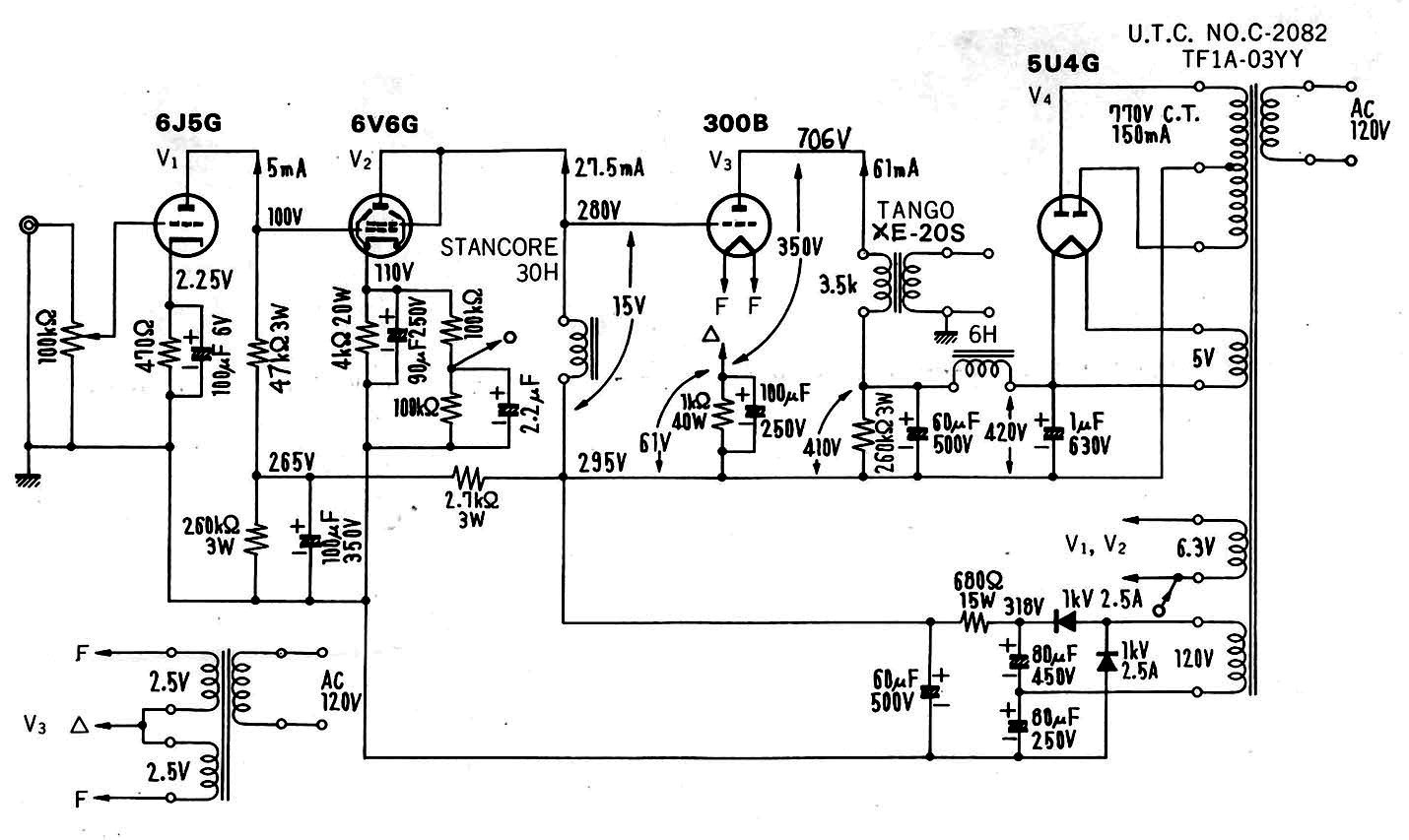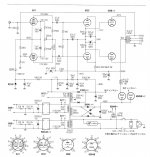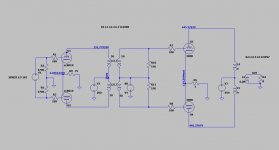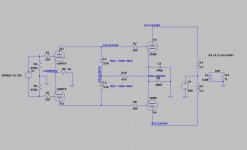I ve googled around a bit, but did not find e.g. the monkey from Th.Loesch in PP anymore as the lnks are down...basically a DRD, but in PP. But besides this, any direct-coupled version would be interesting to compare...especially if you can comment the sound as you have build it !
Thx a lot
Thx a lot
Last edited:
I have built several of the monkey/DRD amps with a variety of drivers for both 2A3 and 300B; but I have never built a PP DRD. There several classic circuits that it might be useful to study; but they all use the iron either as grid chokes as the Altec 260 or as a cathode follower load as the Bogen. Here's the Bogen J50:
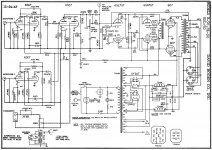

Its not PP, its single ended.
http://www.pearl-hifi.com/06_Lit_Ar...apers/Loesch_Thorsten/Thorsten_on_SE_Amps.pdf
http://www.pearl-hifi.com/06_Lit_Ar...apers/Loesch_Thorsten/Thorsten_on_SE_Amps.pdf
I once researched on that too. These do not exist.
Otherwise, I'd recommend the Shoog's (DIY member) approach, of what he did with 6080. Separate/shifted B+ sources for deriver vs output stage will get you what you want.
The problem always is if the driver tube is accidentally missing/burnt - you lose the valuable 300 one too, a big turn off.
Otherwise, I'd recommend the Shoog's (DIY member) approach, of what he did with 6080. Separate/shifted B+ sources for deriver vs output stage will get you what you want.
The problem always is if the driver tube is accidentally missing/burnt - you lose the valuable 300 one too, a big turn off.
I did a google and found out this one:
https://www.audioasylum.com/cgi/t.mpl?f=tubediy&m=160300
It is at that other forum but Michael Koster is a member here as well.
but Michael Koster is a member here as well.
https://www.audioasylum.com/cgi/t.mpl?f=tubediy&m=160300
It is at that other forum
Michael Koster's amp requires a preamplifier with a fair amount of gain and balanced output. SY's Impasse Preamplifier could give you that. It also requires separate +470V DC and -380V DC supplies.
I built a PP 2A3 amp that was similar, but its input is at ground, and it uses a 6N6P instead of the ECC99. It has a negative supply for the cathodes of V1 (6N6P or ECC99) so that it can use a DN2540 CCS down there for balance. That way you wouldn't need an input transformer doing the phase splitting. I used a single 6DJ8 as a line stage (single-ended/unbalanced) which fed the 6N6P LTP with CCS in the tail, feeding the PP 2A3s. It works, but I think it can be improved. The trick is that it uses 'stacked' DC supplies. The input 6N6 LTP has a +170V DC supply, referenced to ground (0V). The PP 2A3 output stage DC supply has its 'ground' 'lifted' on top of the +170V input stage DC supply. 45V is dropped across the PP2A3 cathode resistor (common to both cathodes). About 5V is dropped across the LTP plate choke, leaving the 2A3 tubes with -40V grid-cathode bias. It works, believe it or not, but I think it would work better with a balanced input like Michael Koster's.

A direct coupled push-pull 300B amp with input sensitivity high enough that it can be used without a line stage preamp is possible, but it would require 'stacked' power supplies and a center-tapped plate choke for the push-pull driver stage. Be very careful about the high voltages involved.
- First stage and second stage would share a single 400V DC power supply, with its ground to earth (0 volts).
- Output (third) stage would have its own 400V DC power supply, floating on top of the first/second stage power supplies DC voltage.
- The first stage would be an LTP with plate resistors, and a negative voltage feeding the LTP tail. A CCS would be a good idea in the LTP tail.
- The second stage would be a differential (push-pull) driver with a center-tapped plate choke (or autoformer if you prefer). The DC voltage drop across the plate choke would be quite small.
- The output stage would be cathode biased with the cathode's 'ground' end connected to the +400VDC input stage B+. In other words, the output stage floats on top of the input stage B+.
Otherwise, have a look at the Crystal Palace amplifier in Morgan Jones "Valve Amplifiers" (3rd ed. and 4th ed.). That amp uses 13E1 pentodes strapped as triodes, but could be adapted to 300B tubes.
I built a PP 2A3 amp that was similar, but its input is at ground, and it uses a 6N6P instead of the ECC99. It has a negative supply for the cathodes of V1 (6N6P or ECC99) so that it can use a DN2540 CCS down there for balance. That way you wouldn't need an input transformer doing the phase splitting. I used a single 6DJ8 as a line stage (single-ended/unbalanced) which fed the 6N6P LTP with CCS in the tail, feeding the PP 2A3s. It works, but I think it can be improved. The trick is that it uses 'stacked' DC supplies. The input 6N6 LTP has a +170V DC supply, referenced to ground (0V). The PP 2A3 output stage DC supply has its 'ground' 'lifted' on top of the +170V input stage DC supply. 45V is dropped across the PP2A3 cathode resistor (common to both cathodes). About 5V is dropped across the LTP plate choke, leaving the 2A3 tubes with -40V grid-cathode bias. It works, believe it or not, but I think it would work better with a balanced input like Michael Koster's.

A direct coupled push-pull 300B amp with input sensitivity high enough that it can be used without a line stage preamp is possible, but it would require 'stacked' power supplies and a center-tapped plate choke for the push-pull driver stage. Be very careful about the high voltages involved.
- First stage and second stage would share a single 400V DC power supply, with its ground to earth (0 volts).
- Output (third) stage would have its own 400V DC power supply, floating on top of the first/second stage power supplies DC voltage.
- The first stage would be an LTP with plate resistors, and a negative voltage feeding the LTP tail. A CCS would be a good idea in the LTP tail.
- The second stage would be a differential (push-pull) driver with a center-tapped plate choke (or autoformer if you prefer). The DC voltage drop across the plate choke would be quite small.
- The output stage would be cathode biased with the cathode's 'ground' end connected to the +400VDC input stage B+. In other words, the output stage floats on top of the input stage B+.
Otherwise, have a look at the Crystal Palace amplifier in Morgan Jones "Valve Amplifiers" (3rd ed. and 4th ed.). That amp uses 13E1 pentodes strapped as triodes, but could be adapted to 300B tubes.
Oh i just saw that i posted the wrong schematic - here again!
An externally hosted image should be here but it was not working when we last tested it.
So version 2 has a stacked psu as i can see?
No,
there is only one (1) PSU. So it can not be stacked. Everthing is in topology.
I did similiral amp in 2018 - 6C4C in PP (Loftin White).
Dissipating 32W on that poor R5 thoughthere is only one (1) PSU
Nevermind, now I just want to know what is the PPIT100 interstage transformer (can't find a single mention except for this schematics)Oh i just saw that i posted the wrong schematic
Hi together,
i would like to unbury this thread. I found a schematic wich will fit the needs of the OP. But as others say it will be impossible - i'm asking myself if it could work. But let's see what others say:
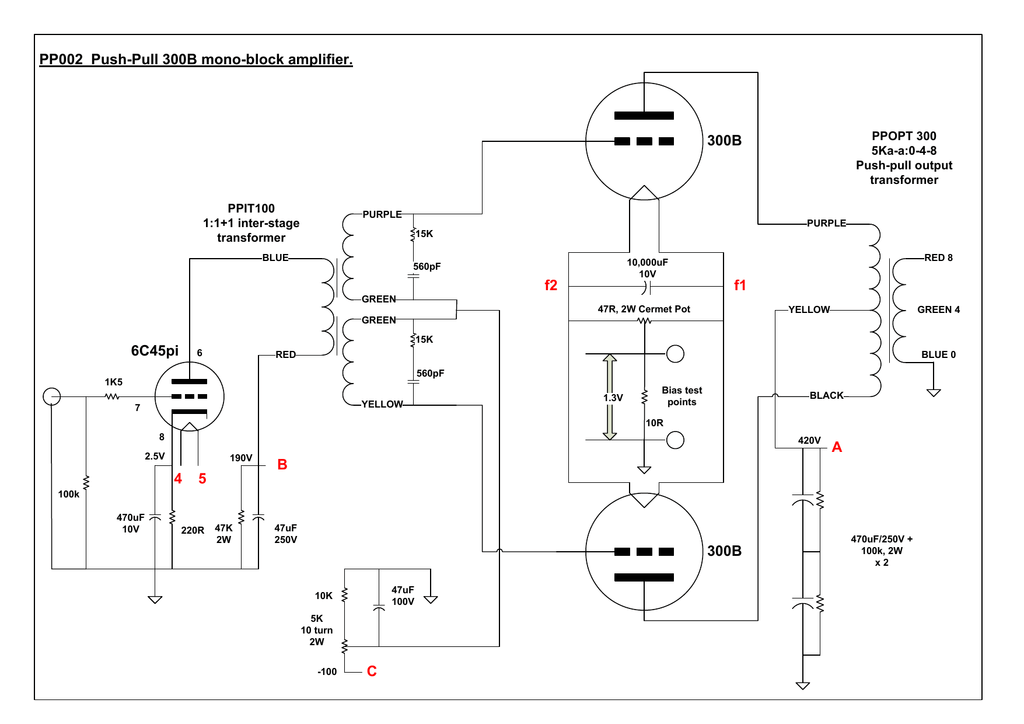
I've built very similar designs around Sovtec 6B4Gs with varying results. I couldn't find or have built an adequate interstage.
It may be better to have the push pull transformer at the input.
Oh i just saw that i posted the wrong schematic - here again!
I've built designs like this around 6H30s and Sovtec6B4Gs with very good results. A good place to start.
- Home
- Amplifiers
- Tubes / Valves
- Schematics of direct-coupled 300B Push-Pulls ?
